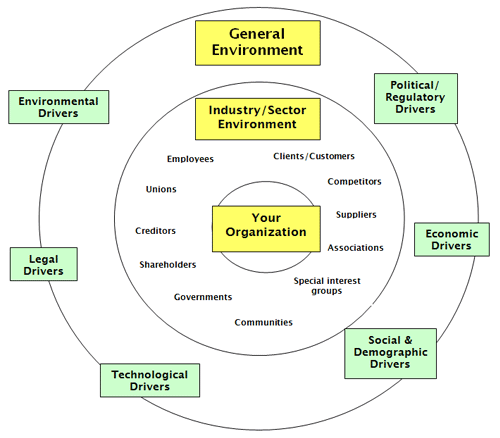By Dr. Carol A. Beatty, Senior Research Fellow, Queen’s IRC
“Everything should be made as simple as possible, but not simpler.”
— Albert Einstein
People management professionals are often exhorted to become more knowledgeable about business strategy but many are discouraged by the jargon and the apparent complexity of the field. While it is true that a radical rethink of your organization’s strategy involves creativity and specialized skills, most regular strategic planning exercises do not require that level of sophistication. In this article, I will follow Einstein’s advice and aim to demystify the organizational strategy process by removing the jargon and boiling it down to five simple questions. Answer these questions and you will be able to meet the challenges of most strategic planning situations.
Your strategic planning group should set aside uninterrupted time to discuss and come to consensus on these simple questions:
- What business are we in and how are we doing now?
- What’s happening around us? Are there any serious dangers in staying where we are – i.e. sticking with the same business and strategy?
- If so, is there a better place for us to be?
- How do we get there?
- How will we know we have arrived?
Question 1: What business are we in and how are we doing now?
What business are we in? This question appears basic but your group may be surprised at how little agreement exists initially about your business definition. It is as though we live in the “same, different” organization. Moreover, if there are new participants at the table or if you have not had this discussion in some time, agreement on what business you are in is essential before proceeding further.
Start with your mission statement unless it is too lofty or theoretical. Or start by discussing the following sub-questions.
- What do we do?
- For whom?
- Where?
- How?
- What are the key success factors of this business? (What do we have to do extremely well to satisfy clients and succeed over the long term?
For example, at a recent strategic retreat of the Board of Directors of a Canadian not-for-profit organization, participants decided their business definition was:
We examine/evaluate the evidence on medical equipment and drugs to provide credible advice to decision-makers at various levels of Canadian health care. Guided by the priorities of these decision-makers, our reports, recommendations and tools are used to choose the right drugs and technologies and are consulted by health funders, providers, institutions and patients.
In order to deliver on this business definition, the retreat participants decided the following key success factors were critical: Trusted/Credible; Relevant/Useable; Independent; Timely; and Affordable.
How are we doing? There are many approaches to assessing organizational health. The simplest and fastest way is to take the key success factors that you have agreed upon and review how well the organization is delivering on each of them. If you are in a high-tech business, for example, one of the key success factors might be getting new products to market before the competition. If that’s the case, you need to measure how fast your organization invents, produces, and markets its new products compared to others in the industry. Each business will have different key success factors and so this assessment is based on having a thorough understanding of your own.
Another approach to organizational assessment is the Balanced Scorecard, which uses a number of categories to rate organizational health (these vary depending on the industry and sector). Or you could use industry or sector specific benchmarks that the leadership group considers relevant comparators. For example, in one municipality, benchmarks were established using the National Quality Institute’s Public Sector Criteria for excellence.
Finally a more thorough approach is to conduct an organizational audit. An audit involves a comprehensive review of all important operational and strategic areas of the organization. It can be conducted through questionnaires or interviews with stakeholders or undertaken by the leadership group. The categories for review can include: organizational structure, culture, leadership, managerial climate, human resources, communications, technology, financial, capital and other resources, market share and customers, intellectual capital, relationships, and key result areas.
The approach you use will depend on the time available and the comprehensiveness desired. If necessary a consultant can be hired to provide an objective and non-threatening way to obtain input from stakeholders, especially staff members.
Question 2: What’s happening around us? Are there any serious dangers in sticking with the same business and strategy?
A scan of the relevant environment, both internal and external, helps to identify whether there are serious dangers to the organization in staying where we are – i.e. sticking with the same business and the same strategy. What are the driving forces affecting the organization now and in the near future? If your group does not take them into account, flaws in thinking and logic can too easily sabotage the quality and implementation of the strategic plan. If this scan is considered too technical or time-consuming for internal members to undertake, a consultant can be hired to assist.
Figure One is a helpful pictorial representation of the most common strategic change drivers that you may want to consider in this part of your strategic planning process. Some may not be relevant to your organization; likewise some may be missing, depending on your industry and sector. Before committing a lot of time scanning widely, establish which areas you will pay most attention to. But beware, you may be blindsided by developments seemingly coming from nowhere you if your scan is too narrow.
Figure One – Scan of Strategic Change Drivers
After your group has decided on the most relevant areas to scan, answer the following questions:
- What are the major events, developments, and trends happening in this part of our environment that will have an impact on our organization? Which are most critical for us to deal with in the near future?
- What are the characteristics of our industry (commodity or high value? growing or declining? diversifying or consolidating?). Are these characteristics shifting? If so, what are the implications?
The answers to questions about the industry/sector and general environment will likely involve research. The choice of how to gather information for this assessment is a key one. If you measure the wrong things, you will miss opportunities and may be blindsided by problems that seem to come out of nowhere. Good sources of information can come from:
- Commissioning formal reports
- Researching via press, web, or other published data
- Chartering a team/task force to do the research and produce a report
- Engaging industry associations
- Meeting with the employees who liaise directly with a specific group of interest
- Inviting an expert or representative of the relevant industry group to speak at summits or meetings
- Holding a regular environmental scan meeting
- Putting yourself in the shoes of a specific group (such as customers or competitors) and imagining their responses to the questions
- Doing a mind map with a cross-section of members of your organization to tap into their collective knowledge
After you have completed your scan, a SWOT (strengths, weaknesses, opportunities and threats) matrix can be used as a tool to summarize your deliberations (see Figure Two below).
Finally your group should consider the second and most important part of our simple question. Namely, are there serious dangers in staying where we are and sticking with the same strategy? Is the business you are currently in a viable one in light of what’s happening in the environment? Is there a good fit between the present strategy and the environment? A changing environment might mean that your present business model and strategy are becoming problematic.
Figure Two: SWOT Matrix
| Strengths | Weaknesses |
| Opportunities
|
Threats |
Question 3: Is there a better place for us to be?
If you have concluded that you are in some danger or that there is a wonderful opportunity, either now or in the near future, and that a change in strategy is desirable, the next step is to agree upon changes in strategic direction. Do you need to make a radical change in the way you complete? Or do you need to modify our value proposition – a smaller change in direction? Do you want to change your mix of services/products/markets served in order to grow or at least stop decline? Or does your current strategy merely need tweaking?
This part of the strategic planning process is probably the most difficult and the one that requires the most creativity. Given all you know about our internal capabilities and challenges from the organizational assessment and all you know about the external environment right now, how can you create a sustainable advantage for your organization?
There are several approaches and tools that can help your group think through this part of the strategic plan, depending on how radical the change in strategic direction must be. The most radical is a change in generic strategy, or the way in which you compete for the loyalty of your customer/clients. Can you create more value by changing some aspects of our generic strategy? The generic strategies are :
- Winning through cost:
- Winning through great products or services:
- Winning through customer intimacy:
- Winning through choosing a profitable niche.
On the other hand, if you have a viable business model but find that your growth has stagnated, consider growing the business by choosing one of four following strategic changes:
- Same products/services, same markets. This strategy involves increasing our market share by taking business away from our competitors.
- Different products/services, same markets. This strategy involves creating new products or services adjacent to those we currently offer and marketing them to our current customers.
- Same products/services, different markets. This strategy involves entering new markets (for example, crossing international borders) with the same product/service mix.
- Different products/services, different markets. This strategy involves entering new markets with new products/services both at the same time.
It should be noted that these strategies are listed in order of risk from least to most. Few organizations have been able to successfully implement the fourth strategic direction.
A third possibility, and one of the simplest strategic changes to make, is a decision to retrench to the core of the organization. This strategy is most appropriate if you have taken on too many products/services or have responded in an ad hoc manner to opportunities that have arisen. It is usually a problem for smaller or younger organizations that have struggled to survive and grow, although this situation can occur in huge conglomerates that have tried to manage a number of unrelated businesses. This strategic refocus involves deciding on which activities are both profitable and essential to the identity of the organization and ceasing to engage in those that do not meet these two tests.
After your group has come to consensus, summarize the strategic direction chosen as follows:
Our Strategic Direction:
In the next 3 years, we will focus on____________________________________________________________
in order to ______________________________________________________________
Our Strategic Goals:
The following are the stretch goals to reach this Strategic Direction. (No more than five)
Our Strategic Vision:
What will our organization look like when we achieve our Strategic Goals?
Question 4: How do we get there?
Having a vision and goals at a high level is good, but you will not arrive at the destination without more detailed planning. You must translate the broad strategic goals into specific objectives and action plans to be carried out in the near term. Without these, the entire strategic planning effort can turn into a mere theoretical exercise. The goals should be detailed into clear objectives that can be measured, assessed, and revised if necessary. The objectives are then assembled into action plans that include specific activities that must be undertaken, measurements that will be made, deadlines, persons responsible for carrying out the activities, and follow up that will be undertaken. Each of the strategic goals can be summarized by using the template offered in Figure Three (note that a separate template will be necessary for each goal).
After the goals have been detailed into objectives, each of the objectives should be detailed into action plans that specify key actions required to reach the objective, each with its own deadline, responsibility, resources required, and measures of achievement. Once this is accomplished, a formal written ‘strategic plan’ should summarize the decisions of the entire strategic planning process.
Figure Three: Turning Goals into Objectives
Strategic Goal 1:
| Objectives | Time Horizons for Completion | Lead person or group responsible for completion |
| 1. 2. Etc. |
Year 1:
Year 2:
Year 3:
|
Question 5: How will we know we have arrived?
A specific follow-up system should be developed to ensure that the plans will actually be fulfilled instead of being put on a shelf to gather dust. Devices such as a monthly executive review, reports due, and yearly strategic planning updates should be decided by your group before you finish your plan. Measures of progress and success should be planned and rigorously taken. Monitor progress regularly, with strategies revised and annual objectives developed yearly thereafter, based on the progress made and obstacles encountered.
Final Thoughts
These five simple questions can guide your organization through strategic planning in most situations. Remember, implementers often complain that senior managers have a short attention span and do not continue their interest and support throughout the implementation phase. The statistics on successful implementation of new strategies are not encouraging, so don’t assume your tasks are completed after the plan has been written and communicated. The unwavering support of your strategic planning group and senior executives will be necessary to see it through to a successful outcome.
Treacy & Wiersema, The Discipline of Market Leaders, 2000
Michael Porter, The Five Forces that shape Strategy, Harvard Business Review, January 2008
Copyright © Industrial Relations Centre, Queen’s University, Canada. Reprinted with permission.
Queen’s University Industrial Relations Centre is a leading provider of practitioner training and research in the areas of human resource management, industrial relations, and organization development. For more information, visit the IRC web site: www.IndustrialRelationsCentre.com.
Article Source: http://www.hr-info.com






